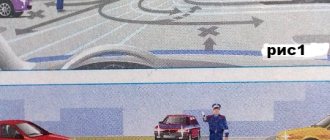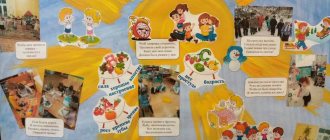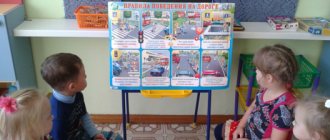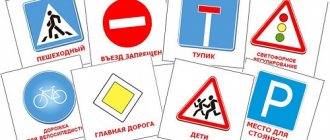Plan for traffic rules in the senior group for 2. For kindergarten teachers, school teachers and educators Natalya Asanova Plan for traffic rules in the senior group for 2. Joint activities of the teacher with children.
Independent activity of children. Working with parents. September. Lesson “I am a pedestrian - I am a passenger.” Target walk to the crosswalk. Reading works: G. Georgiev “Traffic Light”, S. Mikhalkov “Uncle Styopa - Policeman”. Looking at illustrations.
Folder for parents “Road Rules”
IN
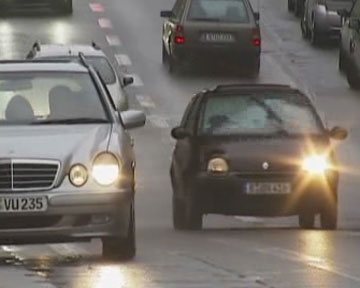
Summer has come - a wonderful time for vacations and school holidays, swimming, long walks and playing in the fresh air. Unfortunately, it is in the summer that the percentage of child injuries as a result of road traffic accidents increases. To prevent accidents on the road, it is necessary to conduct traffic safety classes in kindergartens and schools. And, of course, conversations between parents and their children about the rules of behavior on the roadway are of great importance.
H
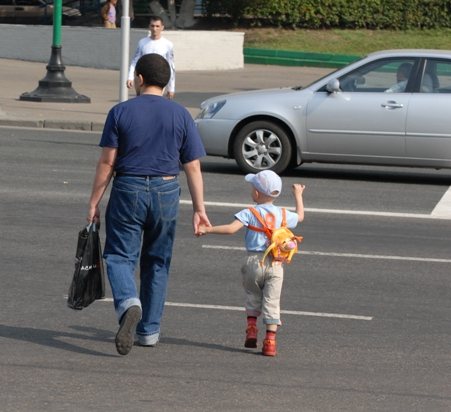
.
Another common mistake parents make is acting on the principle “you can do it with me.” If you show your child by your own example how to run to red, be sure that when left alone, he will try to repeat this trick.
Recommendations for teaching children traffic rules:
When leaving home:
— If there is possible movement at the entrance of the house, immediately pay attention to the child to see if there is any approaching traffic.
— If there are vehicles at the entrance or trees growing, stop your movement and look around to see if there is any danger.
When driving on the sidewalk:
— Keep to the right.
— The adult must be on the side of the roadway.
— If the sidewalk is next to the road, parents should hold the child’s hand.
—
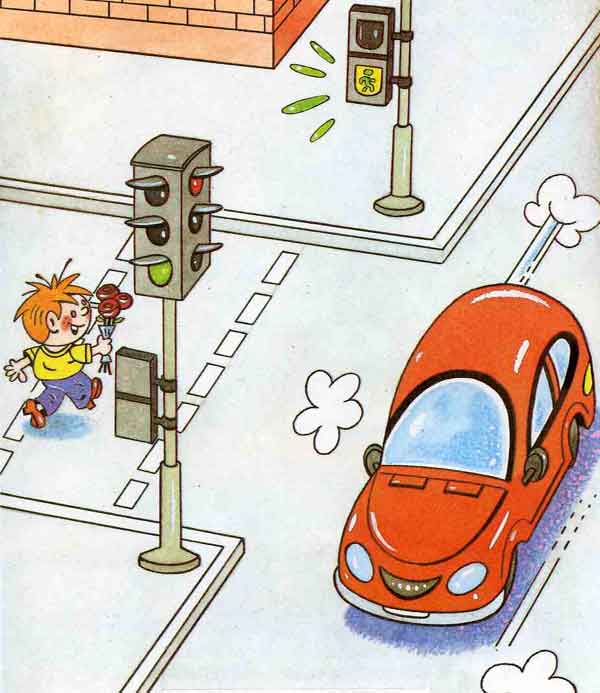
Teach your child to carefully watch cars leaving the yard while walking along the sidewalk.
When preparing to cross the road:
—Stop and look at the roadway.
— Develop your child’s observation of the road.
- Emphasize your movements: turning your head to scan the road. A stop to inspect the road, a stop to let cars pass.
— Teach your child to peer into the distance and distinguish approaching cars.
— Do not stand with your child on the edge of the sidewalk.
— Draw the child’s attention to the vehicle preparing to turn, talk about the turn signal signals on cars.
— Show how the vehicle stops at the crossing, how it moves by inertia.
Screen "Safe pedestrian" consultation on the topic
Memo for parents.
Road safety
Dear moms and dads!
Remember that the life and safety of children on the roads depends primarily on you.
Teach your children how to behave safely on the road by example!
It is important to teach them to observe, navigate the situation on the road, assess and anticipate danger. When you're on the road with your children, use some techniques to help you and your child develop safe behavior skills.
- Never rush on the roadway.
- Do not cross the road when the traffic light is red or yellow.
- When getting off a bus, tram, or taxi, remember that you must do so first.
- After getting off public transport, wait until it leaves the stop, and only then cross the road.
- Don't talk while crossing the road.
- Never cross the road diagonally.
- Constantly discuss emerging traffic situations with your child, pointing out hidden dangers.
- Particular attention should be paid to children with vision problems. Lateral vision plays a huge role when crossing the street.
- Train yourself and teach your children to cross the road not where you need it, but where there are crossings.
- Teach you to peer into the distance and estimate the speed of approaching transport in order to be able to calculate the time in which the car will be able to get to you.
- Pay attention to the deceptiveness of empty roads. They are no less dangerous than animated ones.
Consultation for parents
“Safety rules for children. Road safety"
When crossing the street, you should always look left first, and when you reach the middle of the road, look right.
You can cross the street only at pedestrian crossings. They are indicated by a special sign “Pedestrian crossing”
If there is no underground crossing, you must use a crossing with a traffic light.
Outside populated areas, children are only allowed to walk with adults along the edge towards cars.
If your parents have forgotten which side to go around a bus or tram, you can remind them that it is dangerous to go around these vehicles both in front and behind. You need to go to the nearest pedestrian crossing and cross the street along it.
Under no circumstances should you run out onto the road. You have to stop before the road.
You cannot play on the roadway or on the sidewalk.
It is safest to cross the street in a group with a group of pedestrians.
Recommendations for parents
1. When driving on the sidewalk:
— stick to the right side of the sidewalk;
- do not lead the child along the edge of the sidewalk: the adult must be on the side of the roadway;
2. When preparing to cross the road:
— stop or slow down, inspect the roadway;
- involve your child in monitoring the situation on the road;
- emphasize your movements: turning your head to look around the street, stopping to look at the road, stopping to let cars pass;
— teach your child to distinguish between approaching vehicles;
- do not stand with your child on the edge of the sidewalk, as when passing the vehicle can get caught, knocked down, or run over with its rear wheels;
— repeatedly show your child how the vehicle stops at the crossing, how it moves by inertia.
3. When leaving home:
- immediately draw the child’s attention to the movement of vehicles at the entrance and together look to see if a car, motorcycle, moped, or bicycle is approaching you;
- if there are vehicles at the entrance or trees growing that block your view, stop your movement and look around to see if there is any danger behind the obstacle.
4. When waiting for public transport:
- stand with children only on landing platforms, and if there are none, on the sidewalk or curb.
5. When crossing the roadway:
- cross the road only at pedestrian crossings or at intersections along the marked zebra crossing line, otherwise the child will get used to crossing wherever he has to;
- don’t rush and don’t run; always cross the road at a measured pace;
- do not cross the road diagonally; Emphasize, show and tell your child every time that you are walking strictly across the street, that this is being done for better observation of cars and motor vehicles;
- do not rush to cross the road if you see friends, relatives, or acquaintances on the other side. Don’t rush and don’t run towards them, instill in your child that this is dangerous;
- do not start crossing a street where traffic rarely passes without looking around;
- Explain to your child that cars can unexpectedly leave the alley or the yard of the house;
6. When boarding and disembarking from public transport:
— go out in front of the child, as the baby may fall, and an older child may run out from behind the standing vehicle onto the roadway;
— approach the vehicle door to board only after a complete stop: a child, like an adult, can trip and get run over;
- do not board public transport at the last moment when it departs; The front door is especially dangerous, as you can get under the wheels of a vehicle;
— teach your child to be careful in the bus stop area, a particularly dangerous place for him: a stopped bus reduces the view of the road in this area.
7. When the car is moving:
— teach children to sit in the car only in the back seat; do not allow anyone to sit next to the driver unless the front seat is equipped with a child seat;
— do not allow a small child to stand in the back seat while driving: in the event of a collision or sudden stop, he may fly over the back of the seat and hit the front window;
- Do not allow children to be in the vehicle unattended.
Memo for parents:
Safe steps towards road safety.
What should parents know about their child?
- At 3-4 years old, a child can distinguish a moving car from a stationary one, but he is sure that the car stops instantly.
- At 6 years old, with peripheral vision he sees approximately 2/3 of what adults see; cannot determine what is moving faster: a bicycle or a sports car; does not know how to correctly distribute attention and separate the essential from the insignificant.
- At 7 years old, it is more confident to distinguish the right side of the road from the left.
- At 8 years old - can instantly respond to feedback, etc.; has experience of walking on the road; actively masters basic cycling skills; can determine the source of noise; establish a connection between the size of an object, its distance and time (the closer the car, the larger it is).
Consultation for parents:
"Road Lessons"
Don’t waste time on “lessons” on how children behave on the street. No one can replace parents in the matter of developing disciplined behavior in a child on the street. No one can replace parents in the matter of shaping their child’s disciplined behavior on the street and their compliance with safety rules.
Remember: before entering school, your child must know and perform well:
- Play only away from the road.
- Cross the roadway slowly and only at the pedestrian crossing.
- Do not cross the path of approaching traffic. Beware of stopped vehicles (a moving car may be hidden behind them).
- Enter and exit any vehicle only when it is completely stopped.
- Get out of the car only on the right side when it approaches the sidewalk.
- When crossing the street at a traffic light, you must give way to cars with a flashing light and sound signal on, and to all violating drivers.
- Children must know when crossing the road:
- First, find a safe place to cross. (Just find it, because the crossing is not always nearby. This place should be as far as possible from cars and other obstructions to the view).
- Stop on the sidewalk near the curb. (Be sure to stop! You always need to stop. You should not get out or run onto the road right away).
- Look around and listen to see if there are any cars (to look around means turning your head both to the right and to the left; to listen means to throw all extraneous thoughts out of your head and remember that the car may not be visible), and if an approaching car is visible, let it pass . Look around again.
- If there are no cars nearby, you can cross the road, and only at right angles to the sidewalk.
Continue to look and listen carefully until you cross the road. At the beginning of the school year, be sure to walk with your child on his route to school. Remember the basic skills of behavior on the road.
Every child should know 4 basic laws of road safety:
“THE HIGHER THE SPEED, THE GREATER THE DANGER”
“BEFORE ENTERING THE ROADWAY - STOP!”
“IF YOU CAN’T SEE IT, STOP!”
“BE ABLE TO SEE, OBSERVE AND FORESEE, ACT SAFELY!”
Memo on organizing a subject-development environment for traffic rules.
Preschool
educational institutions are the main link in the system of education and upbringing of children, where they can and should acquire the necessary knowledge, abilities, skills and habits of safe and law-abiding behavior on the streets, roads and in transport.
The main goal of creating a road safety corner is to teach children the rules of the road and master the skills of safe behavior on the road.
The corner can be designed like this:
1. Location and design of the center.
- free approach;
— openness and accessibility of the material;
— taking into account age characteristics
;
- aesthetics and practicality of the material;
— availability of material for modeling (houses, trees, cars, road signs, etc.;
— technical training aids.
2.Didactic material:
— schemes for the safe movement of pedestrians (from home to kindergarten, from home to school, etc.)
- cards for viewing;
— subject pictures (problematic situations on the road, children playing in the yard, safety of crossing the roadway, etc.);
— photographs and postcards on the topic: “What could happen if... ?
;
— children's fiction (poems, educational stories, stories about road signs)
;
- road signs - pedestrian crossing, pedestrian traffic is prohibited, roundabout, bus stop, caution - children, telephone, medical aid station, food station, movement to the right or left. ;
— traffic light for cars and pedestrians.
— printed board games; to consolidate knowledge about road signs and traffic rules;
— stencils and templates for modes of transport.
3. Play equipment.
— construction designers;
— attributes for a role-playing game (wands, whistles, a policeman’s cap, driver’s license, toy cars for transporting toys, flags for crossing the street, steering wheels, tool kits for car repairs, badges, first aid kit, hats with pictures of cars, etc. .)
4. Methodological equipment
.
- layout of streets and roads;
— map of Novokuznetsk or microdistrict;
— carpet according to traffic regulations;
— posters;
— methodical
literature on organizing work with children;
— availability of educational didactic and handout materials in accordance with age
.
Considering the important role of parents in teaching children traffic rules, the corner for parents should contain:
1. Information about the state of road traffic injuries in the city
2. Causes of road accidents involving children
3. Recommendations for parents on teaching children how to behave safely on the road.
4. List and description of games aimed at consolidating children’s existing knowledge of traffic rules

